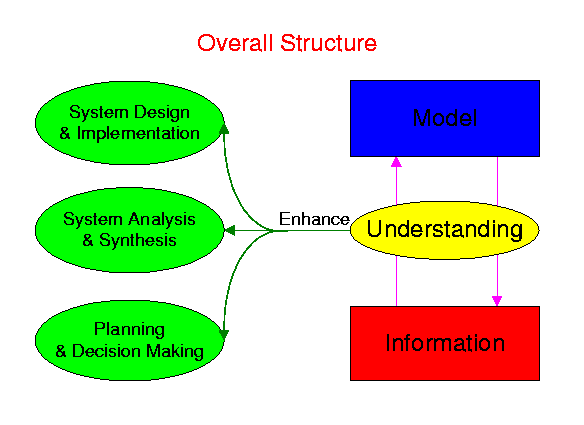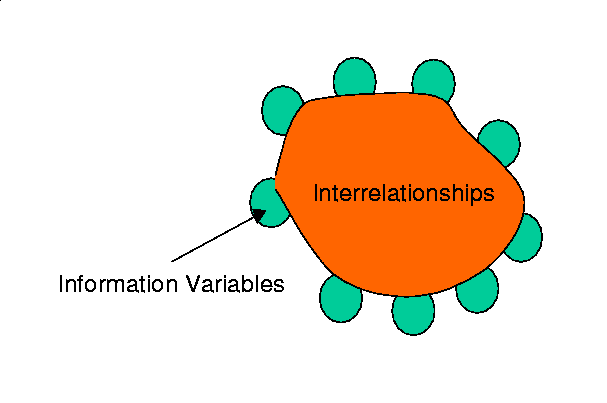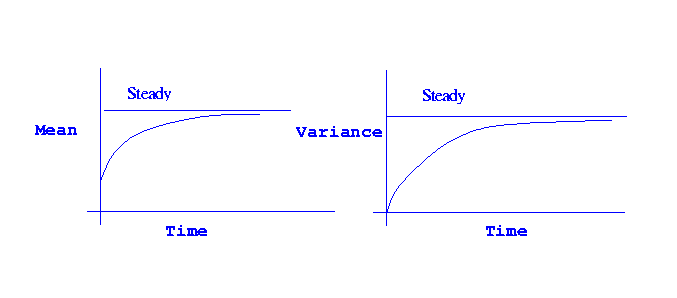Background
The fundamental design goal of complex systems and infrastructures is
to communicate, manage, and analyze information. Yet despite the
central role that information plays in such contexts, a
process-centric approach has dominated most system design endeavors.
We propose Information Dynamics as an alternative paradigm in which
design and implementation are driven by information-centric
considerations. Under this approach, the role information plays in a
system is explicitly considered, with system design taking into
account what information is needed and when, the location of the
information, and the effects of data transfer on the content, value,
and interpretation of information.
Of course, the use of information for effecting control and other decisions is not new. Physical systems respond well to various classes of controllers, for example, when the physics is well understood and the controllers have rigidly compartmentalized responsibilities. But decision making in contexts in which there is no nice physics, such as network-based distributed systems, poses a different kind of problem. Although there have been many related research efforts in the areas of game theory (and later team theory) and autonomous agents, none of this work explicitly considers the temporal effects of the value of information, and how this affects system performance. For this reason, we believe that Information Dynamics is not an incremental approach to any existing work, but informed by this work, takes an orthogonal look at the problem.
[Contents] [Next] [Back to Information Dynamics Project]
Goals
Information Dynamics aims to provide a sufficient understanding
of the fundamental characteristics of information in order
to better design and implement systems. This approach can be
realized either as a philosophical guideline for
the design of systems, or through the more structured Information
Dynamics Framework, a flexible abstract infrastructure intended to
facilitate the analysis of the information dynamics properties
and requirements of proposed system models and implementations.

[Contents] [Next] [Back to Information Dynamics Project]
Definition of Information and
Fundamental Properties
We all have an intuitive notion of what information is, but making
this precise is hardly intuitive.
Information is a property, characteristic, or description of something
physical, logical, virtual, or conceptual. That "something" may be
other information. It may a group, an action,
or a choice. Or it may be a relationship between any of these things.
Regardless of exactly how it is defined, there are several
properties of information that we feel are fundamental.
[Contents] [Next] [Back to Information Dynamics Project]
Information Dynamics Framework
The Information Dynamics Framework describes systems in reference
to three aspects:
We use the term "entity" as the generic abstraction for those objects that perform all system operations. Entities may be physical, such a a processor or network interface card, logical, such as an abstract module interface or service, or created recursively from other entities. These serve as the basic building blocks of any system.
Entities require energy, for carrying out system actions, as well as information, which must be the basis for all actions. An entity may obtain information from external sources (i.e. other entities) and may themselves be contained within other entities. In this way, the entity abstraction is closely related to issues of information aggregation and disaggregation -- a collection of cooperating or related entities can as a group be considered an entity at a higher level of abstraction, and a single entity may be decomposed into sub-entities in order to observe system behavior at finer resolutions.
Entities can be characterized according to the degree of freedom with which they interpret information and react on the basis of that information. Active entities are capable of autonomous actions, and as such do not require that all actions are the result of external input. Reactive entities are capable of carrying out actions only under commands received from other active entities. Passive entities can be either consumable, as when a concurrent server creates a separate thread to handle individual client requests, or permanent, as in an iterative server.
Entities interpret information and perform decisions based on the contents of their information base. This information base contains information about the entity itself, such as its history and capabilities, about the behavior models and histories of other entities, and about the environment in which the entity exists. Information on capabilities include the entity's ability to communicate and to manage and acquire energy for actions, as well as the specifics of permissible or possible actions (e.g. which programs/algorithms can it execute). Among the entities in a system will be some whose only actions are physical in nature, such as actuators, others who perform any or all of information processsing, organizing, and analyzing, and some with reasoning and decision making abilities.
An entity can be viewed either internally or externally. The external view of an entity is comprised of the interfaces exported by the entity, as well as any internallly observable bahaviors. This view will often be influenced by the observing entity, and specifically by the behavior the observer expects. In addition, a single entity may have multiple external views, perhaps corresponding to various "subspaces" of system behavior. The internal view is comprised of the perceived reality, its capabilities, including the ability to "learn" (i.e. add programs or add data to its information base), and the "composition" of the entity, which may involve a list or collection of sub-entities that comprise this entity.
Among the most important attributes of the internal view of an entity is its "perceived reality". An entity maintains its view of the universe in the form of this perceived reality. This perceived reality is based on the explicit information received and processsed by the entity, along with any "model of the universe" with which the entity may have been intitiated. As explicit information is received, it is processed in order to integrate it with the current perceived reality. This integration is based on the model of the universe, and mayd u result in changes to that model. In additon, perceived reality is the basis from which implicit information can be derived from explicit information, since the derivation of implicit information requires an appropriate interpretation of explicit information, and such an interpretation can only be based on the entity's understanding of the universe. Similarly, and most inportantly, an entity can act only on the basis of its understanding of the universe, and thus all actions are initiated based on the perceived reality.
The use of information requires action. Action can create or capture information, store it, move it, transform it, or destroy it. Information can be processed to make implicit information explicit, to initiate another action, i.e. defining a "choice", or to activate a physical operation as output.
As we use ithere, action refers to processing that consumes resources and takes time. As resources reside at specifi locations, actions are carried out at locations. It typically uses information as input, and starts under the control of choice. The outcome of an action may be additional information, choice, storage of information, movement of information, or somephysical results in the form of commands to actuators, etc.
We use the term "choice" to define the control function. Choice defines what action has to be carried out where, at what time, under what conditions, and using what resources. It is based on information and its location/time value.
Note that choice is generated by processing information. Therefore the relationship between information and choice must be part of the implicit information. The interrelationships between information and choice may be fixed, leading to a hardwired design as a design-time choice. When the relationships are dynamic, the choice must reflect this.
We use the term "information variable" to refer to a piece of information and its associated metadata. An information variable consists (at least) of the following:
We may associate a value attribute to an information variable using the confidence indicator and context vector. Clearly, the value of information depends on its use or purpose (what we call context. The value of information changes with time, typically decreasing with time. When the underlying system is static, the value may, likewise, remain static. Under some circumstances the value may increase with time, as later information makes it more valuable. In this regard the value of information may also be associated with the interrelationships between information variables. The confidence indicator may be represented by uncertainty models.

[Contents] [Next] [Back to Information Dynamics Project]
Implications for distributed systems
Consider the implications of information dynamics for distributed systems. Such a system has a collection of entities (processing resources) capable of carrying out certain operations. A specific distributed system, designed to carry our a specific mission, uses physical resources to carry out actions and to store and move information. When such a system is interacting with an external physical system it also has sensors and actuators.
A distributed system may be considered a collection of nodes with a defined network infrastructure for communicating among them. Let us examine the participation of a node in processing. The node maintains its view of the universe in the form of "perceived reality" which is based on
At any node in a distributed system, all actions are initiated using the knowledge of its perceived reality that is not always explicitly defined or represented. The explicit representations may only have been used at design time, and the final system may contain only those parts that are considered essential for operations, retaining only such relationships that may be activated at runtime.
A far reaching consequence of the movement of information is that the perceived reality at any node CANNOT be assured to be the same as the actual reality at any remote node. Transmission delays assure that information received from any remote node is, by definition, historic. Further, it is not sufficient to receive messages; they must be interpreted and processed to integrate them with the local perceived reality. While the perceived reality of a node cannot be assured to be the same as the actual reality of a remote node, it can be consistent with models of remote reality.
[Contents] [Next] [Back to Information Dynamics Project]
As a concrete example of the impact of information dynamics on a practical problem, consider the link-state routing mechanism for computer networks. In this method, routes are chosen to be the shortest path from the source to the distination as determined according to the current knowledge of the link states. The common practice is for routers to periodically measure the wiating times of their links, and broadcast this information so that all nodes have it and can use it in route determination.
Let us now consider the basic characteristics of the performance of a link. In a typical network the link is continuously transferring packets, handling the load as it is presented to the link. If we consider this link as a server, we can characterize its steady state behavior in terms of the mean, w, and the variance, v, of the waiting time. Let w(t) be the waiting time at this particular link as measured at time t. Assuming the measurement is done correctly, the variance of this measurement, v(t), is zero. Given no additional information about the state of the link, our estimate of the waiting time w(t1) at some later time t1 will have to be based on w(t) and our knowledge of w. This estimate will have a variance, v(t1), which will not be zero. In fact, the variance will be an increasing function of the difference t1 - t, tending towards the steady state value v. Given w(t) and v(t), the actual values of w(t1) and v(t1) can be estimated with knowledge of the stochastic behavior of the link.
In this example, the basic information variable is the waiting time estimate for the link and the variance estimate is its confidence indicator. Recognizing that the transfer of the content of w(t) to any other nodes in the network takes time, we require that any new estimates be made taking into account the information dynamics of the situation. Depending on the characteristics of the link, the estimates w(t1) and v(t1) may come so close to the steady state values w and v that the new measurements will have no significant impact on the link information retained by another node. As a consequence, we can significantly reduce the communication required for supporting link-state routing while at least maintaining the quality of routing decisions, if not improve them, by taking into account the variance of the delay estimates. Each node does need the steady-state information about the links. Note that if the steady state conditions change regularly, the knowledge of the time and magnitude of these chances can also be given to individual nodes. The key impact, though, is that by taking the value of information into account, the information dynamics approach allows us to improve the design of the routing mechanism.

The Information Dynamics approach can also play an important role in agent infrastructures. The time-based agent environment provides time-aware fusion, coordination and operations. When an agent receives multiple pieces of information with different time stamps, it fuses the pieces considering the temporal characteristics of information, the agent's current perceived reality, and the variability of the local clock. In a time-based coordination paradigm, each agent performs its action at a time that is determined a priori, as opposed to event-based coordination mechanisms which operate through the exchange of messages.
There is a recent movement towards an information-centric view in the development of technologies to disseminate and publish Web data. For instance, the XML (Extensible Markup Language) standard has become an increasingly popular extensible tagging mechanism for effectively processing Web information. This mechanism can be viewed as a mechanism for explicitly describing the contents of information as well as as some forms of its associated metadata. The growing popularity of XML illustrates the importance of using the characteristics or properties of information. XML, however, does not consider dynamic aspects of information.
[Contents] [Next] [Back to Information Dynamics Project]
Proposed Research
The activities for the Information Dynamics group at the University
of Maryland involve each of
research, development and implementation.
We need to address issues of Representation Theory, Analytical Pragmatics, and Framework Specification. A Representation Theory needs to provide ways for representations to capture the characteristics of information, including associated metadata, content, and the dynamics of value in context. Analytical Pragmatics include devloping an analytic framework that can both present and evaluate system behaviors and designs, and aid in the analysis and understanding of the relations of various information attributes and their specifications, as well as the inherent constraints on this analysis. Based on the Representation Theory and Analytical Pragmatics, a framework specification will allow us to formulate practical problems.
We propose to develop a prototype framework that will operate on multiple platforms in a distributed environment with instrumentation for performance evaluation. The framework will support composability, interoperability, extensibility, and portability of systems and system components. Our target applications include control, logistics, intelligence and crisis management applications.
We propose to first apply the Information Dynamics approach to synthetic (toy) and internetworking problems, and validate the approach through these results. Following this, more extensive applications will be pursued.
[Contents] [Next] [Back to Information Dynamics Project]
![]()